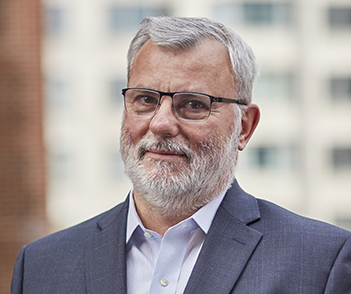EVIDENCE BASED INSIGHT
Clinical Evidence Generation — Why and How
September 21, 2020 • 5 min read
PETER KOTANKO, MD, FASN • FRANKLIN W. MADDUX, MD, FACP • OLAF SCHERMEIER, PhD
Fresenius Medical Care has created a Clinical Evidence Generation (CEG) research initiative as part of its product development process. CEG focuses on researching a product’s real-world clinical value across the company’s diverse global footprint. It does not replace existing research relationships, but instead uses the company’s broad and deep expertise to provide additional insights and information. Incorporating this incremental data into the product development cycle will help Fresenius Medical Care anticipate the needs of diverse stakeholders and communities worldwide.
Today, stakeholders and decision makers in healthcare are facing an ever-growing tsunami of information regarding drugs, products, and diagnostics. A novel noun—“infodemics”—describes fittingly the scenario where an excessive amount of information concerning a problem makes the solution more difficult.
Seeking “evidence”—the available body of facts or information indicating whether a belief or proposition is true or valid—is a time-tested means to sort the wheat from the chaff. “Evidencebased medicine,” with philosophical origins going back to mid-19th century Paris and earlier, is the “conscientious, explicit, and judicious use of current best evidence in making decisions about the care of individual patients.”1 Physicians, nurses, and payors make decisions about the use of products and drugs primarily guided by evidence of clinical effectiveness and health economic considerations. It is Fresenius Medical Care’s responsibility to provide the necessary evidence regarding the company’s products.
Early in 2020, Fresenius Medical Care started a new crossorganization collaborative initiative focusing on Clinical Evidence Generation (CEG) research, a new clinical research category designed to support the company’s development and introduction of new products globally. While Fresenius Medical Care has conducted evidence studies in the past, CEG research is designed as a more focused and coordinated collaboration with medical officers in the Global Medical Office, engineers in Global Research and Development, and marketing leadership within the business regions.
CEG research produces evidence clarifying the scientific efficacy and clinical value for the diverse global communities of users who will benefit from these innovations. It is important to note that CEG neither replaces nor changes how Fresenius Medical Care organizes the regulatory path or life cycle research for the maintenance of existing products. Further, CEG research does not affect other clinical/analytical research in which the company participates or collaborates with other investigators, some of which may also contribute to the clinical evidence portfolio on a particular subject. The CEG research initiative is guided by the business’s launch priorities and influenced by the medical and scientific leadership across the company’s many disciplines. As a key strategy for long-term sustainability, this is an important opportunity to work together to broaden the reach of Fresenius Medical Care’s therapeutic, diagnostic, and connected health platforms to improve the lives of the patients we serve in healthcare markets around the world.
It is important to recognize that CEG is an ongoing process that starts with the pre-development phase of products and continues all the way to post-marketing (phase 4) studies (Figure 1). CEG research should ultimately support the launch and market introduction of products that improve patient care. For this to be possible, CEG research must evaluate outcomes that reflect realworld scenarios and address the concerns of patients, physicians, and payors. Explanatory trials are most frequently designed as randomized controlled trials (RCTs). Fresenius Medical Care has years of experience in conducting RCTs.
FIGURE 1 | Clinical evidence generation is an ongoing process overseen by a governing body
In RCTs’ simplest form, patients are randomly allocated into two groups (“arms”) that undergo specific interventions, e.g. a treatment with different dialyzers. Well-designed RCTs provide the highest level of evidence, because known and unknown patient factors are balanced between the two arms through the randomization process. Over the years, numerous RCT variants have been developed. However, RCTs frequently call for often complex inclusion and exclusion criteria that may limit generalizability of results to the larger population of interest.
In conventional RCTs, patients are randomized; in cluster randomized trials, the unit of randomization is a group, such as an entire dialysis clinic or geographic region. Cluster randomized trials are the main tool used in pragmatic clinical trials (Figure 2). Given the sheer scale of Fresenius Medical Care, with its thousands of dialysis clinics worldwide, this trial design holds great promise. Fresenius Medical Care North America has practical experience with this type of randomized trial. Pragmatic trials may test the same interventions as explanatory trials, but they are conducted in real-world clinical practice settings and the eligibility requirements are often relaxed. In general, pragmatic trials demonstrate a better sense of how an intervention works in the real world.
FIGURE 2 | Comparison of randomized controlled trials with cluster randomized trials
To be successful, CEG requires an elaborate communication strategy (Figure 3). CEG is most effectively communicated through publications in journals respected by all stakeholders. A spectrum of publications is necessary to cover various aspects of a product, such as a new dialyzer. These individual publications, large and small, are like dots in pointillistic artwork: They create an all-encompassing description of a product. Of course, a successful product launch requires a host of additional activities such as marketing, product placement, and pricing, to name a few.
FIGURE 3 | CEG communications strategy and partnerships
CEG is not a tick-box exercise. It requires a deliberate, focused, and well-coordinated cross-functional approach, bringing together different skill sets from across Fresenius Medical Care (Figure 4). Given the organization’s many talented and dedicated top-notch employees versed in planning and conducting research, the company is well-equipped to successfully execute CEG research. In doing so, Fresenius Medical Care is dedicated to serving patients, caregivers, healthcare professionals, and larger societal health goals, in conjunction with meeting company objectives.
FIGURE 4 | CEG cross-functional matrix organization
Meet The Experts
References
- Sackett DL. Evidence-based medicine. Seminars in Perinatology 1997 Feb;21(1):3-5. https://doi.org/10.1016/S0146-0005(97)80013-4.



